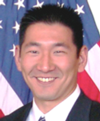Military, Homeland Security & Emergency Response Applications
Track Coordinators: Todd E. Combs and Matthew Berry, Argonne National Laboratory
The Military, Homeland Security and Emergency Response Applications track is interested in papers that describe the application of simulation methods to problems in the military, homeland security, and emergency response. Applications may be in any area related to military such as battlefield simulation, military logistics/transport, military man power planning, etc. For homeland and emergency response applications are sought in the protection of critical infrastructure, transportation security, bio-defense, and the phases of the emergency response lifecycle, i.e., preparation/training, response, recovery and mitigation, etc. Simulation applications that illustrate the relationships between the military and homeland security and emergency response are especially welcome.
Military Keynote
 Timothy H. Chung is an Assistant Professor of Systems Engineering at the Naval Postgraduate School in Monterey, California. His research interests include modeling and analysis of operational settings involving unmanned systems, notably information gathering and sensor fusion for search and detection missions using probabilistic and optimization models. Combining algorithm development with field experimentation, active research pursuits include systems design of large teams of cooperating and adversarial robots. Such efforts involve integration of modeling, algorithms, hardware, simulation, human factors, and control, leveraging extensive research collaborations. He received a Ph.D. and M.S. at the California Institute of Technology in mechanical engineering and a B.S. in mechanical and aerospace engineering at Cornell University. Timothy H. Chung is an Assistant Professor of Systems Engineering at the Naval Postgraduate School in Monterey, California. His research interests include modeling and analysis of operational settings involving unmanned systems, notably information gathering and sensor fusion for search and detection missions using probabilistic and optimization models. Combining algorithm development with field experimentation, active research pursuits include systems design of large teams of cooperating and adversarial robots. Such efforts involve integration of modeling, algorithms, hardware, simulation, human factors, and control, leveraging extensive research collaborations. He received a Ph.D. and M.S. at the California Institute of Technology in mechanical engineering and a B.S. in mechanical and aerospace engineering at Cornell University.
Monday, December 7
Advancing Autonomous Swarm Capabilities: From Simulation to Experimentation
With increasing availability and proliferation of unmanned system technologies, such as unmanned aerial vehicles (UAVs) in civilian and military applications, both opportunities and challenges arise in addressing large numbers of robots capable of collective interactions. In this presentation, we present active research efforts in the Advanced Robotic Systems Engineering Laboratory (ARSENL) at the Naval Postgraduate School exploring future concepts, mathematical, algorithmic, and simulation models, and live-fly field experimentation of UAV swarms. We highlight and address a number of the specific considerations for modeling engagements between adversarial swarms of autonomous systems, in which the two swarms have opposing mission objectives. Such efforts require further development of autonomous swarm tactics, leveraging existing and future enabling technologies in a holistic, system-of-systems context. This presentation also provides results and lessons learned from both extensive simulation-based studies and also recent field experiments, as part of a live-fly testbed development effort to support rapid innovation and exploration of such future concepts for advanced research and education. |
|
